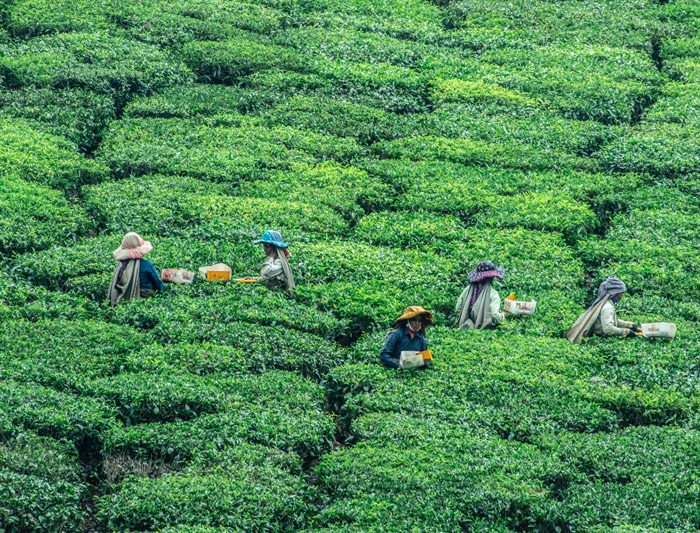
As if the climate and biodiversity crises were not enough, the global food crisis is here as well. Already last November, Secretary-General António Guterres told the G20 Summit in Indonesia that the “crisis of affordability” would create a “raging food catastrophe” in 2023. Rising prices place food beyond the reach of the poor. The climate crisis is disrupting crop cycles and fisheries. Debt-burdened governments in the Global South do not have the fiscal space to help their people. This is a global governance challenge on a par with nuclear war.
What is driving the global food crisis?
Now Professor Jem Bendell, in a chapter on food system breakdown from his upcoming book Breaking Together about societal collapse, has used interdisciplinary integrative analysis to identify six hard trends which will drive a global food system breakdown. Cultural and institutional factors from our systems of capital and power, and the assumptions they are built on, create biases that are interfering with the needed radical change.
First, he says we are reaching the biophysical limits of food production. Despite the green revolution and all the technological innovations in farming, there have already been two years in this century when global food production fell short of demand, and the rate of growth in food production has declined to the point that demand could outstrip the supply of calories as early as 2027. The biophysical limits include the loss of agricultural land to soil degradation and conversion to other uses, the biological limits to plant and animal production, declining yields in industrial agriculture, the water crisis, and the emergence and spread of diseases.
The oceans have been both contaminated by urban, industrial and agricultural pollution and raped by industrial fishing fleets. Toxic pollutants and microplastics are now everywhere in the environment.
Second, we are destroying and poisoning the biosphere that agriculture relies on. We have altered three quarters of the ice-free land surface, with half already converted to food production. Deforestation and the resulting loss of ecosystem services, loss of pollinators with collapsing insect populations, and overuse of water resources are some causes. The oceans have been both contaminated by urban, industrial and agricultural pollution and raped by industrial fishing fleets. Toxic pollutants and microplastics are now everywhere in the environment.

Third, current food production relies on fossil fuels that must be eliminated to stop global heating. The energy for farm machinery and irrigation, fabrication of fertilizers and agricultural chemicals, and processing, transportation, marketing and consumption of food produce more than a third of greenhouse gas emissions. Our industrial farming system cannot continue, but alternative agroecology systems or radical new food technologies cannot be put in place overnight, and rising prices will impact the poor and create social and political instability, as has happened already when some governments have (unsuccessfully) tried to reduce energy subsidies.
Fourth, food production is being constrained by climate chaos, with extreme weather, droughts, flooding, and changing seasons bringing uncertainty to planting and harvesting and driving food insecurity. Yields of staple crops, particularly grains, are falling around the world, with increasing risk of multiple crop failures and inadequate reserves. The oceans are warming and becoming more acidic, with serious impact on wild fisheries and a threatened collapse of marine ecosystems.
RELATED
Lisa Palmer on Our Hot and Hungry Planet
In this episode of the Global Governance Podcast, Augusto Lopez-Claros sits down with Professor Lisa Palmer to discuss how we can strengthen the resilience of our food systems.
Fifth is the rapidly growing demand for food, both from population growth and increasing individual food consumption. Prosperity brings increasing meat consumption with environmental and climate impacts. The consumer lifestyle drives excessive consumption and waste, which the poor dream to emulate. On current trends, we would need to double global food production by 2050, now clearly impossible with a collapse in global ecosystem functions.
Sixth, the globalised food system prioritises efficiency and profit over resilience and equity, increasing the risk of system collapse. Despite abundant food today, nearly a billion people lack adequate food and many are starving due to unjust distribution and access; there are close to 800 million suffering from malnourishment. Financial speculation on commodity prices, corporate monopolies, long supply chains and reduced reserves contribute to supply disruptions and rising prices. The global capitalist system ignores the warnings identified by Bendell, so a tragedy of failing food supplies seems inevitable.
Conclusion
If we want to avoid the “raging food catastrophe” the Secretary-General warned about, with all the knock-on effects on mortality, human security and well-being, urgent drastic action is called for to move to food systems that are localised, diversified, decentralised, autonomous, circular and transparent. From urban gardens to permaculture and restorative agriculture, there are alternatives that might help to navigate the coming global food crisis, at least at the community level. The recent report of the UN High Level Advisory Board on Effective Multilateralism says our multilateral system is lagging behind emerging and fast-moving trends, unable to anticipate and respond to risks before they escalate beyond our control, and calls for steps to broaden our understanding of and response to the growing security risks posed by climate change. More effective global governance might give us the means to accelerate the transition to more sustainable food systems and to respond to the coming humanitarian crises. The longer we wait, the more painful it will be.


